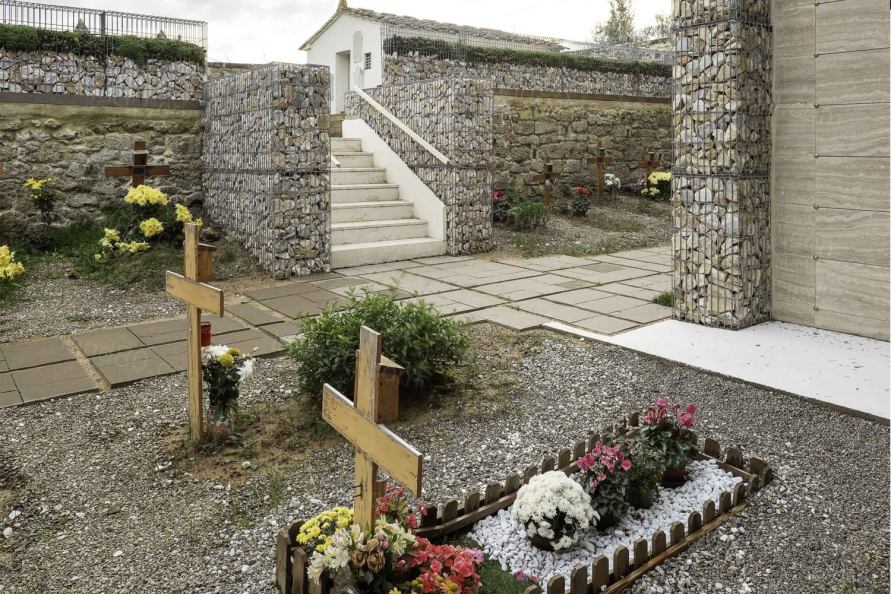在12世纪末,圣吉米尼亚诺(San Gimignano)和科勒•瓦尔德尔萨(Colle Val d'Elsa)实现了完全自治,成为自由的城市,两个区域之间签订了协议,确定了各自的领土区域和扩张政策。1309年至1320年间,双方在蒙特代伊莱奇(Monte dei Lecci)上建立了一座强大的城堡,作为分界线和边界线。很快在它周围拔地而起的小镇叫做圣吉米纳诺城堡(Castel Di San Gimignano)。在13世纪之前,在墓地建造地区的一小群农村房屋和农场里,已经有一座专门纪念圣克里斯蒂娜的教堂。圣吉米纳诺城堡的墓地是托斯卡纳乡村“坎波桑托”的典范:表达了村里发现的西维塔斯人及其农地,这是生命的源泉。
At the end of the 1200s, San Gimignano and Colle Val d'Elsa achieved full autonomy as free Municipalities and a pact of friendship was established between the two, which defined the territorial areas and expansion policies. Between 1309 and 1320, a mighty castle was erected on Monte dei Lecci, acting as a line of demarcation and control. The town that soon sprang up around it was called Castel di San Gimignano. Before the 1300s there was already a church dedicated to Santa Cristina located in a small group of rural houses and farms in the area where the cemetery was built. The cemetery of Castel San Gimignano is a paradigmatic example of a "camposanto" in the Tuscan countryside: an expression of the civitas found in the village and its agricultural land, a source of life.

Photo©Filippo Poli

Photo©Filippo Poli

Photo©Filippo Poli

Photo©Filippo Poli
其统一的设计语言在改造后的项目里仍然清晰可见:围栏内有交错高度的石头砌筑和墓地,沿着土地的坡度呈梯田状,多条流线连接着场地内两块高差不同的区域。
The typological characteristics of its uniform shape are still clearly visible: an enclosure with stone masonry and burial fields at staggered altitudes, following the slopes of the land in a terraced pattern. The multiple entrances follow the articulation of the two upper and lower fields.

Photo©Filippo Poli

Photo©Filippo Poli

Photo©Filippo Poli
石头边墙与北侧一排柏树平行,而在东西方向的入口附近有几颗稀疏的柏树,与较低的场地一致。
The stone border wall is enhanced along the north side by a row of cypresses, while other isolated cypresses are found near the east and west entrances in line with the lower burial ground.

Photo©Filippo Poli

Photo©Filippo Poli
柏树在视觉上介导了墓地与周围景观的融合。该结构以极简主义和简单性对景观的价值仍然得到了很大程度的保留,既是查看该景观的特权点,又是其在墓地边缘的自然延续,是一种视觉上的连续体。重建项目需要在现有的完整空间和空白空间之间建立平衡的关系。石笼墙的新功能包含局部石灰石与边界墙和干石墙的线性顺序对话,标志着上下田之间的高度变化。教堂般的形状创造了一个适合祈祷和纪念的空间。新的两个石块的雕塑质在内部和外部、充满和空旷、过去和现在之间产生了辩证关系。
The cypresses visually mediate the cemetery's integration into the surrounding landscape. The structure's value to the landscape, in its minimalism and simplicity, is still largely preserved, both as a privileged point for viewing this landscape and as its natural continuation at the cemetery's edges, in a sort of visual continuum. The redevelopment project entailed a balanced relationship between existing full and empty spaces. The new feature of the gabion walls containing local limestone, which trace the new niches, dialogue with the linear sequence of the boundary walls and the dry stone wall marking the change in height between the upper and lower fields. The chapel-like shape of the new niches creates a space suitable for prayer and remembrance. The sculptural mass of the two stone cubes of the new volume produce dialectical relationships between interior and exterior, full and empty, past and present.

Photo©Filippo Poli

Photo©Filippo Poli

Photo©Filippo Poli
有意识地选择使用石墙用于斜坡和土地的围护,这是基于本土文化的张力。
The conscious choice to use an architectural component (gabion walls) usually used as containment for slopes and land was based on this place's manifest tension.

Photo©Filippo Poli
干燥的石墙代表着与那些生活在圣吉米纳诺堡环境、公民和文化背景下的人的生活直接的物质和精神联系。一个充满历史和工作的地方,与土地在一起,为土地服务:这是一个关于生存和生活的思考。两块田之间的干石梯田墙被修复加固,并在顶部放置了由天然线形石笼和多种景天植物。连接两个场地的台阶也进行了翻新,肩部被新的石笼结构取代。此外,两条以不同大小的预制混凝土砌块铺设的小径已干铺和铺上草地,标志着不同地区之间的路线。上面的田地已经从旧的拆迁中解脱出来,种上了草。最后,对破损的灰泥进行了维修工作,并修复了现有小礼拜堂和墙壁的外部。新的柏树软化了视觉冲击,建造于20世纪70年代的旧墓穴,茉莉花植物沿着石笼墙的两侧生长。随着季节的流逝,它们会改变墙的外观,这是对记忆和生活在短暂的生命中是如何融为一体的隐喻。
The dry stone walls represent the direct physical and spiritual connection with the lives of those who have lived in the environmental, civic and cultural context of Castel San Gimignano. A place full of history and work, with and for the land: a matter of sustenance and life. The dry stone terrace wall between the two fields has been restored and consolidated, and a protective shoulder made of natural linear gabions with multivarietal sedum plant essences has been placed at the top. The steps connecting the two fields have also been renovated, with the shoulders replaced with new gabion structures. In addition, two paths paved with different sizes of prefabricated concrete blocks have been dry-laid and grassed, marking the routes between the various areas. The upper field has been freed from the old demolitions and planted with grass. Lastly, maintenance work has been done on the damaged plaster and the restoration of the exterior of the small existing chapel and the walls. New cypresses soften the visual impact with the old burial niches built in the 1970s, and jasmine plants grow along the sides of the gabion walls. As the seasons pass, they will change the wall's appearance, a metaphor for how memory and life are all one in the transience of life.

Photo©Filippo Poli

Photo©Filippo Poli

Photo©Filippo Poli

Photo©Filippo Poli

Photo©Filippo Poli

Photo©Filippo Poli

Photo©Filippo Poli
▼项目剖面图

▼建筑单元剖面图

设计单位:MICROSCAPE architecture urban design AA
客户:圣吉米尼亚诺市(SI)
项目周期:2016-2019
工程与安全总监:MICROSCAPE architecture urban design AA
团队成员:Patrizia Pisaniello(建筑师),Saverio Pisaniello(建筑师),Luigi Aldiccioni(3D视觉艺术家),Francesco Rinaldi(地质学家),Luca Bargagna(地质学家)
执行公司:Costruzioni Sirio srl
面积:600平方米
照片:Filippo Poli
Client: Municipality of San Gimignano (SI)
Project: MICROSCAPE architecture urban design AA
Director of Works and Safety: MICROSCAPE architecture urban design AA
Team members:
MICROSCAPE architecture urban design AA (architects Patrizia Pisaniello & Saverio Pisaniello)
architect Luigi Aldiccioni - 3D Visual artist
geologist Francesco Rinaldi
geologist Luca Bargagna Studio GAIA
Executing company: Costruzioni Sirio srl
Size: 600 m2
Photo © Filippo Poli
Timeline
Planning: 2016
Site work: 2019
|